Bringing to life a Leonardo sketch
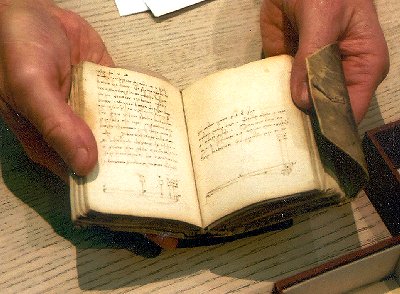
One of the original Leonardo da Vinci notebooks at the V&A
In October 2001 Rufus Marsh* and I were fortunate to be able to view several of Leonardo da Vinci's original notebooks and manuscripts at the Victoria & Albert Museum (Forster Codex) and the British Library (Arundel Codex). After Leonardo's death in 1519 his notebooks were stored and partly organised by his student and companion Francesco Meizi. Later these notebooks were collected and sold off. There are now about 20 collections (each called a Codex) surviving around the world. The three pocket books we saw at the V&A was an especially wonderful opportunity to hold and look through the originals. Many notes and sketches were made on these viewings. His notebooks are particularly inspiring to us because we both make and invent machines and apparatus. They are timeless drawings and designs.
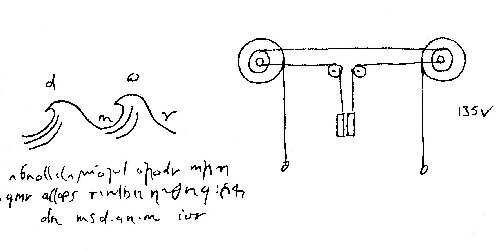
Drawing based on the original by Leonardo da Vinci now in the Arundel Codex (British Library, London).
One diagram caught my attention (see above) because although it was simple it was also quite complex! The little sketch involves eight pulleys; two pairs of three pulleys each fixed together on the same shaft and two single pulleys. There were also five strings, or ropes, that threaded through this pulley arrangement. In Leonardos notes books he often drew a pump as a rectangular symbol and so I believe this sketch was of a design arranged to move heavy water pumps. The drawing does not reveal if the movement was to be by manpower or some other motive force. The fifth string, or rope going between the two sets of three pulleys was intriguing and looked as though it should stop the pumps from being moved in the same direction (i.e. you could not pull on both at once - they were out of phase with each other). To test to see if this was correct I decide to build a prototype from the sketch.
Sketched-in near to the pulley drawing was a nice representation of two water waves (see above). This is rather interesting as the motion of a 'particle' of water as a wave passes follows a circular path rather like the circular motion of the pulleys going round. What impresses me so much about his drawings are that they look so fresh and new in comparison to the writing and numbers.
Building Leonardo
My nephew, Samuel Hare and I set out to make a prototype from the Leonardo drawing.
1) Samuel and I cut out discs of wood from which to make the pulleys on a band saw, drilled and glued them to make up the, two sets, of three joined pulleys.
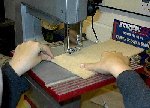
2) The wooden discs were drilled (6 mm hole) in the centre, glue smeared on the faces and threaded through a large nail and left to dry. Weights were put on top of them to apply pressure during gluing.
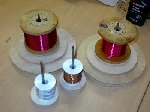
3) A wooden frame was made up and the pulleys were mounted in position.
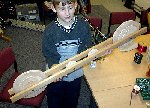
4) The ropes were then fixed in place and weights attached to the 'pump position' ends.
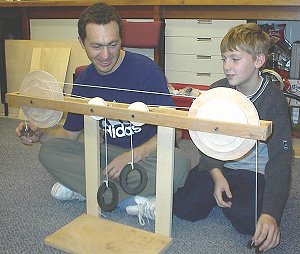
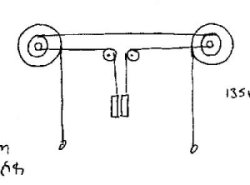
The finished prototype and Leonardo sketch
5) the completed contraption was mounted to a base and tested out. The prototype allowed the two middle weights (the pumps in Leonardo's original) to be moved up and down alternately by alternately pulling the two outer ropes. The pulley system meant that it was easier, by roughly a factor of 2 or 3, to pull the ropes than move the 'pumps'. The fifth rope on the sketch did in deed limit the motion of the pulleys so that only a sea-saw motion could be achieved.
This little project brought to life a 500 year old sketch that Leonardo may have mused about but probably never built!
THANKS TO:
Rufus and I would like to thank NESTA for support during this little project. I would also like to thank Karen O'Connor and Ben Christie at the BBC / Open University for organising the trips to the Museums (lets hope the program is commissioned). We would also like to thank Andrew Russell and Rowan Watson at the Victoria & Albert Museum as well as Mrs Porter at the British Library.
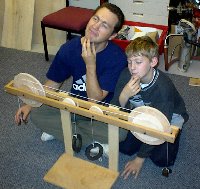
The Philosophers...
Dr Jonathan Hare, E-mail: jphcreativescience@gmail.com
NOTE: Although none of the experiments shown in this site represent a great hazard, neither the Creative Science Centre,
Jonathan Hare nor The University of Sussex can take responsiblity for your own experiments based on these web pages.
THE CREATIVE SCIENCE CENTRE
home | diary | whats on | CSC summary | latest news